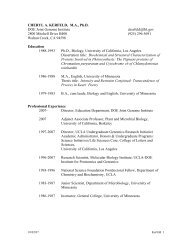DANIEL I ARNON 1910–1994
80 arnon - Department of Plant & Microbial Biology
80 arnon - Department of Plant & Microbial Biology
- No tags were found...
Create successful ePaper yourself
Turn your PDF publications into a flip-book with our unique Google optimized e-Paper software.
<strong>DANIEL</strong> I. <strong>ARNON</strong>.<br />
collaborators) discovered the essentiality of molybdenum<br />
for the growth of all plants and of vanadium for the growth<br />
of green algae. These findings led to far-reaching developments<br />
in the study of nitrogen metabolism, in which both<br />
elements were shown to play critical roles. The molybdenum<br />
research later found agronomic application: The addition<br />
of a small amount of molybdenum to deficient soils restored<br />
fertility and dramatically increased crop yields in many regions<br />
of the world, especially Australia. In later life, well into his<br />
photosynthesis career, he jokingly referred to his nutrition<br />
years as “my first incarnation.”<br />
THE PHOTOSYNTHESIS PERIOD (1951-78)<br />
Arnon’s plant micronutrient work led him to photosynthesis,<br />
where in 1954 he discovered (and named) photosynthetic<br />
phosphorylation (photophosphorylation)—a finding<br />
that ranks in importance with the discovery of respiration<br />
in animals. He demonstrated that chloroplasts use the energy<br />
of sunlight to generate adenosine triphosphate (ATP), the<br />
universal energy carrier of living cells. Arnon discovered<br />
the cyclic type of photophosphorylation in which ATP is<br />
the sole product of energy conversion and the noncyclic<br />
type in which the formation of ATP is accompanied by the<br />
liberation of oxygen and the generation of reductant (reduced<br />
pyridine nucleotide, or NADPH). As a part of this research<br />
Arnon was the first to obtain complete photosynthesis outside<br />
the living cell—a feat comparable to that of Büchner’s<br />
cell-free fermentation. This discovery opened the door to a<br />
new epoch in photosynthesis and made possible the elucidation<br />
of the systems that regulate the assimilation of carbon<br />
dioxide and the paths of biosynthesis of major cellular products.<br />
As has occurred with other major advances, Arnon’s<br />
discoveries were for years either unaccepted or unappreciated<br />
by influential workers in the field.<br />
13




